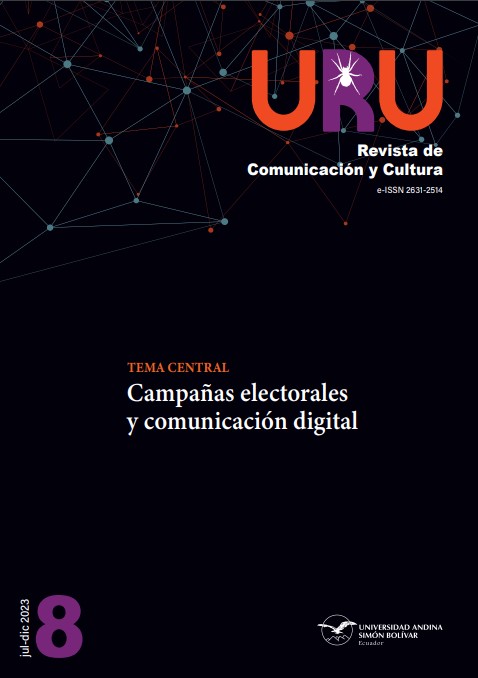Los virus en el cine: Entre la ficción y la pedagogía
Contenido principal del artículo
Resumen
Sin duda, la pandemia del COVID-19 ha traído nuevamente a la ciencia ficción al debate político y social. Las narraciones presentes en ella, que en un momento estuvieron relacionadas a situaciones inverosímiles, hoy en muchos casos se ubican en la esfera pedagógica, que explica posibles escenarios apocalípticos del fin de la humanidad: pandemias, invasiones alienígenas, revolución de las máquinas, entre otros. Sus discursos entretejen lo fantástico y lo científico con la intención de crear un lenguaje espectacular al tiempo que accesible para la mayoría de la población, que busca en estos relatos causas, consecuencias y soluciones a aquello que pone en riesgo la vida en el planeta. Este ensayo parte en primer lugar de una lectura proveniente de las ciencias sociales y, posteriormente, del análisis de películas de ciencia ficción, basándose en la sociología del desastre de Enrico Quarantelli. De esta forma se pretende entretejer el cine de ficción con un discurso pedagógico tendiente a reflexionar sobre las diversas situaciones sociales, económicas, políticas y culturales que provocan los escenarios relacionados a las pandemias.
Detalles del artículo
Sección

Esta obra está bajo una licencia internacional Creative Commons Atribución-NoComercial-CompartirIgual 4.0.
Los autores/as que publiquen en esta revista aceptan las siguientes condiciones:
- Los autores/as conservan los derechos de autor y ceden a la revista el derecho de la primera publicación, con el trabajo registrado bajo Licencia Creative Commons 4.0 de Reconocimiento No Comercial-Compartir Igual 4.0, que habilita a compartir, adaptar y atribuir el trabajo (ver: Políticas de acceso abierto).
- Los autores/as pueden realizar otros acuerdos contractuales independientes y adicionales para la distribución del artículo publicado en esta revista (p. ej., incluirlo en un repositorio institucional o publicarlo en un libro) siempre y cuando indiquen claramente que el trabajo se publicó por primera vez en Uru. En caso de reproducción deberá constar una nota similar a la siguiente: Este texto se publicó originalmente en Uru: Revista de Comunicación y Cultura N° --, año de publicación.
- Se recomienda a los autores/as publicar su trabajo en Internet (por ejemplo en páginas institucionales o personales) en la versión final publicada por Uru: Revista de Comunicaicón y Cultura ya que puede conducir a una mayor y más rápida difusión del trabajo publicado.
Cómo citar
Referencias
Agamben, Giorgio. 2005. Homo Sacer: El poder soberano y la nuda vida. Valencia: Pre-Textos.
Alexander, Jeffrey. 2016. “Trauma cultural, moralidad y solidaridad: La construcción social del Holocausto y otros asesinatos en masa”. Revista Mexicana de Ciencias Políticas y Sociales 61 (228): 191-210. https://bit.ly/41wGdf5. DOI: https://doi.org/10.1016/S0185-1918(16)30045-9
Álvarez, Palmar. 2016. Duelo, precariedad y cultura del cuidado: El ensayo animado como propuesta estética. Madrid: Libros en Acción.
Amis, Kingsley. 1966. El universo de la ciencia ficción. Madrid: Ciencia Nueva.
Ariza, Luis. 2018a. Cine y catástrofe: Un escenario de colapso social ante una crisis global. Madrid: Universidad Complutense de Madrid.
—. 2018b. ¡Vigilen los cielos!: La filosofía de la ciencia ficción. Barcelona: Arpa.
Bassa, Joan, y Ramón Freixas. 1999. El cine de ciencia ficción. Una aproximación. Madrid: Paidós.
Baudrillard, Jean. 2001. “La precesión de los simulacros”. En Arte después de la modernidad: Nuevos planteamientos en torno a la representación, editado por Brian Wallis, 253-81. Madrid: Akal.
Beck, Ulrich. 2006. La sociedad del riesgo: Hacia una nueva modernidad. Madrid: Paidós.
Biskind, Peter. 2004. Mis almuerzos con Orson Welles. Barcelona: Anagrama.
Crespo, Alejandro. 2009. El cine y la industria de Hollywood durante la Guerra Fría, 1946-1969. Madrid: Universidad Autónoma de Madrid.
Díaz, Mario. 2014. “El apocalipsis interior. Dos acercamientos al fin del mundo europeo: Le temp du loup (2003), de Michel Haneke, y Les derniers jours du monde (2009), de Arnaud y Jean- Marie Larrieu”. En Cine y fin del mundo: Imaginarios distópicos sobre la catástrofe. Tomo I, coordinado por Ester Bautista y Jacqueline Gómez, 111-48. Querétaro, MX: Universidad Autónoma de Querétaro.
Foucault, Michel. 2008. Los anormales. Buenos Aires: Fondo de Cultura Económica.
Gubern, Roman. 2006. Patologías de la imagen. Barcelona: Anagrama.
Han, Byung-Chul. 2020. “La emergencia viral y el mundo del mañana”. En Sopa de Wuhan: Pensamiento contemporáneo en tiempos de pandemias, editado por Pablo Amadeo, 97-112. Buenos Aires: ASPO.
Imbert, Gérard. 2014. “Imaginarios posapocalípticos en el cine actual: Entre la vuelta al origen y el fin de la humanidad”. Contratexto 22: 75-89. https://bit.ly/41z079m. DOI: https://doi.org/10.26439/contratexto2014.n022.89
Jameson, Fredric. 2009. Arqueologías del futuro: El deseo llamado utopía y otras aproximaciones de la ciencia ficción. Madrid: Akal.
Korstanje, Maximiliano. 2012. “Contagio y pandemia: Crónicas de un desastre apocalíptico”. Antropología Experimental 12: 261-70. https://bit.ly/3N1OGTj.
Memba, Javier. 2007. La edad de oro de la ciencia ficción (1950-1968). Madrid: T&B Editores.
Montanari, Gianni. 1977. Ieri, il futuro: Origini e sviluppo della fantascienza inglese. Milán: Nord.
Nespereira, Javiet. 2014. “Los discursos de la pandemia: Nuevas estrategias de comunicación del riesgo en un nuevo contexto sociocultural”. Cultura, Lenguaje y Representación 13: 185-99. https://bit.ly/3KXxL1C. DOI: https://doi.org/10.6035/CLR.2014.13.10
Nichols, Bill. 1997. La representación de la realidad. Madrid: Paidós.
Petryna, Adriana. 2016. “Ciudadanía biológica: Ciencia y políticas sobre poblaciones expuestas a Chernobyl”. Redes 22 (42): 83-107. https://bit.ly/3mNSblG.
Quarantelli, Enrico. 1985. “Realities and Mythologies in Disaster Films”. Communications 11 (1): 31-44. https://doi.org/10.1515/comm.1985.11.1.31. DOI: https://doi.org/10.1515/comm.1985.11.1.31
Rose, Nikols. 2012. Las políticas de la vida. Buenos Aires: UNIPE.
Scholes, Robert. 1982. La ciencia ficción. Madrid: Tauros.
Scolari, Carlos. 2005. No pasarán: Las invasiones alienígenas de Wells a Spielberg. Madrid: Páginas de Espuma.
Sontag, Susan. 2008a. Contra la interpretación y otros ensayos. Barcelona: DeBolsillo.
—. 2008b. La enfermedad y sus metáforas / El sida y sus metáforas. Barcelona: DeBolsillo.
Van Loon, Joost. 2002. “A Contagious Living Fluid”. Theory, Culture & Society 19 (5-6): 107-24. https://doi.org/10.1177/026327602761899174. DOI: https://doi.org/10.1177/026327602761899174
Žižek, Slavoj. 2020. Pandemia: La COVID-19 estremece al mundo. Barcelona: Anagrama.


